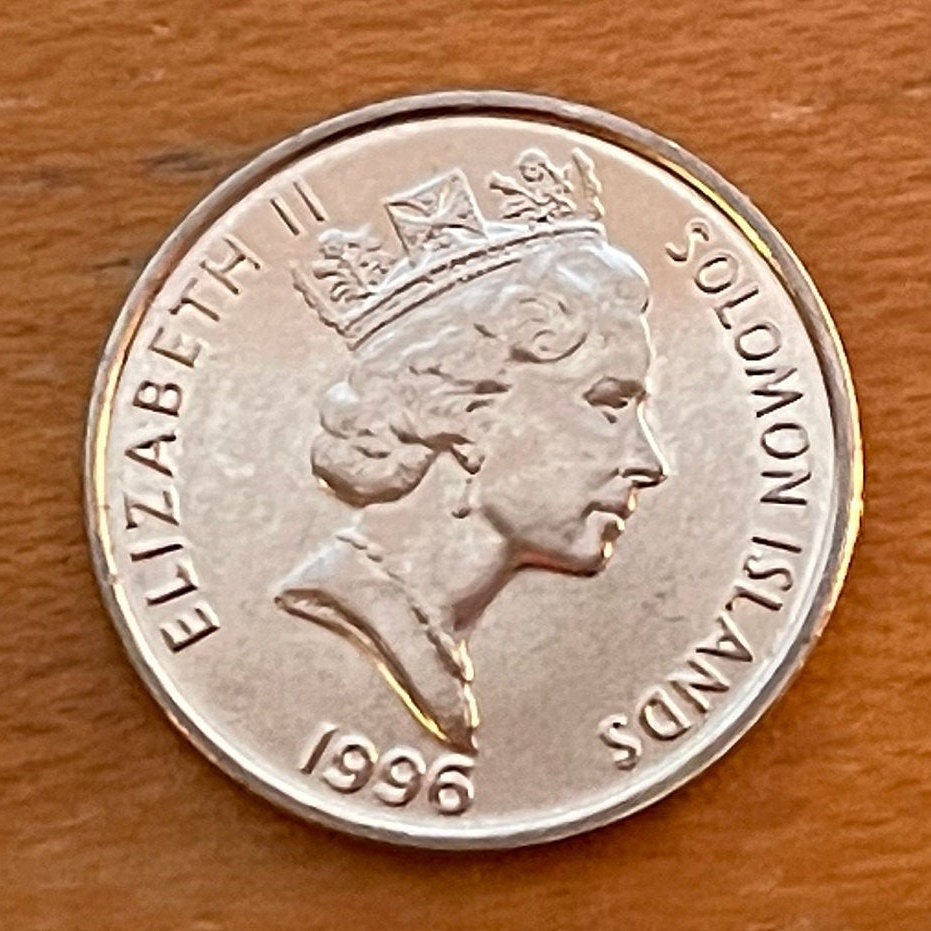elemintalshop
Spirit Funerary Mask 5 Cents Solomon Islands Authentic Coin Money for Jewelry and Craft Making (Headhunters) (Elongated Earlobes)
Spirit Funerary Mask 5 Cents Solomon Islands Authentic Coin Money for Jewelry and Craft Making (Headhunters) (Elongated Earlobes)
Couldn't load pickup availability
Spirit Funerary Mask 5 Cents Solomon Islands Authentic Coin Money for Jewelry and Craft Making (Headhunters) (Elongated Earlobes)
Reverse: Native mask and value.
This 5-cent circulation coin (1977 to 1985) design includes a Santa Ysabel mask. In the Solomon Islands, only the northern part -- like Santa Ysabel -- once used masks made of bark cloth stretched over a cane frame. Their exact usage has been lost to time, but some historians believe the masks were part of funerals up until the 1800s. Wikipedia:
Santa Isabel Island (also known as Isabel, Ysabel and Mahaga) is the longest in Solomon Islands, the third largest in terms of surface area, and the largest in the group of islands in Isabel Province.
Obverse: Queen Elizabeth II.
Lettering: ELIZABETH II SOLOMON ISLANDS
(Wikipedia: Solomon Islands is a constitutional monarchy and has a parliamentary system of government. As Queen of Solomon Islands, Elizabeth II is head of state; she is represented by the Governor-General who is chosen by the Parliament for a five-year term.)
Features
Issuer Solomon Islands
Queen Elizabeth II (1952-date)
Type Standard circulation coin
Years 1987-1989
Value 5 Cents (0.05 SBD)
Currency Dollar (1977-date)
Composition Copper-nickel
Weight 2.8 g
Diameter 19.4 mm
Shape Round
Technique Milled
Orientation Medal alignment ↑↑
Demonetized Yes
Number N# 3484
References KM# 26
*******
"The Solomon Islands"
Emily Caglayan, Ph.D.
Department of Art History, The Graduate Center, City University of New York
October 2004
The Solomon Islands comprise a double chain of seven large and more than thirty small islands, located just east of New Guinea. The islands were named in 1568 by the Spanish navigator Alvaro de Mendaña, who claimed that he had found the riches of King Solomon, or the biblical land of gold. The main islands, which are volcanic in origin, are Choiseul, Santa Isabel, Malaita, New Georgia, Guadalcanal, Makira (San Cristobal), and Santa Cruz. The islands have an estimated population of 455,000. The island of Bougainville, located to the northwest of Choiseul, is geographically and ethnically a part of the Solomon Islands, but politically belongs to the nation of Papua New Guinea.
The art of the Solomon Islands is characterized by its intricate designs, which utilize inlays of pearl shell. Traditionally, these artworks were either signifiers of status and prestige, or related to funerary rituals.
Among the most spectacular art forms from the Solomon Islands are woven-wicker war shields (1978.412.730). These small, elliptical shields are constructed out of wicker and adorned with tiny squares of nautilus shell. The central design is commonly an elongated, anthropomorphic figure surrounded by abstract designs and disembodied faces. Only about twenty shields exist in collections today, all of which are believed to have originated from the Florida and Santa Isabel Islands, between 1840 and 1850. Due to their fragility, it is unlikely that these shields were actually used in combat. Instead, it is hypothesized that they were owned by high-status individuals and traded to Europeans as ritual gifts of exchange.
High-status individuals from the Solomon Islands also traditionally wore pendants (1999.47.21) or round chest ornaments known as kap-kaps (1979.206.1519). These were made from precious materials, such as turtleshell and giant clam shell, and worn to signify status and rank.
Unlike other parts of Island Melanesia, masks were rarely used on the Solomon Islands. Those that did exist were restricted to the northernmost islands (such as Nissan, Buka, and Bougainville), and typically made of barkcloth stretched over a cane frame (1978.412.1518). Unfortunately, little is known about these masks, but they were most likely used for funerals or other important ceremonial occasions.
Prior to the end of the nineteenth century, headhunting was considered by the Solomon Islanders as a necessary part of life that ensured the health and well-being of their community. Headhunting raids would utilize large, plank-built war canoes with crescent-shaped prows and sterns. Anthropomorphic canoe prow ornaments (1976.351) were standard features of the canoes. Positioned at the waterline of the vessel, these ornaments represented mythological spirits whose function was to ward off danger and ensure smooth seas. They were typically painted black and had shell-inlay designs depicting the face-painting designs used by warriors. These figures were also carved with protruding mouths, artificially elongated earlobes (a cosmetic practice in this region), and oftentimes held miniature heads as an allusion to their role in headhunting.
Canoe paddles (1978.412.1491) were also decorated with low-relief anthropomorphic figures, known as kokorra. These figures, depicted in a squatting position with raised hands, were believed to have supernatural powers. As such, they guaranteed the safety and success of their user, and were more than just decorative elements.
Citation
Caglayan, Ph.D., Emily. “The Solomon Islands.” In Heilbrunn Timeline of Art History. New York: The Metropolitan Museum of Art, 2000–. http://www.metmuseum.org/toah/hd/solo/hd_solo.htm (October 2004)
Share










Hard coin to find nice coin.
It was very nice
It's a coin I'll put it in my collection
Still the best coin shop to buy from. I have loved every coin I have bought here. I will be purchasing more coins from this vendor. Love this coin!
Excellent coin, thanks so much.









